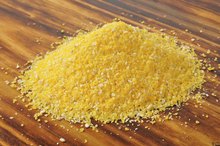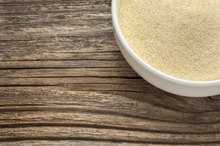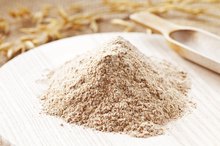Nutrition of Bleached vs. Unbleached Flour
Whether you are using flour to bake bread and cookies or using it as a coating for your favorite fried chicken, the variations in flour contribute to a variety of nutritional values. White flour comes in a variety of forms, including bleached, unbleached and enriched, and each one of these is a little bit different nutritionally and can affect the nutritional value of whatever it is you are cooking. When it comes to bleached and unbleached, the difference is not that big, but enrichment does make a difference.
Bleached and Unbleached
According to "Cook’s Illustrated" magazine, all all-purpose flour is technically bleached. All-purpose flour is generally made in one of three ways that includes either hard red winter wheat, soft red winter wheat or a combination of the two. When the wheat is first processed, it has a yellow tint, but within about 12 weeks, this yellow pigment is oxidized and changes the color to more of a white tint. For bleached flour, this natural bleaching is taken one step further with the use of benzoyl peroxide or chlorine gas to create the bright white color of bleached flour. This bleaching, however, alters the protein found within the flour. Bleached flour is the preferred choice for most consumers as the brighter white color is associated with higher quality.
Bleached and Unbleached Enriched
Grits Nutritional Value
Learn More
According to the USDA Nutrient Database, the nutritional information for both bleached and unbleached enriched flour is the same. A 1-cup serving of this flour contains 455 calories, 12.92 grams of protein, 1.23 grams of fat, 95.39 grams of carbohydrates and 3.4 grams of dietary fiber. Mineral content includes 19 milligrams of calcium, 5.80 milligrams of iron, 135 milligrams of phosphorus and 134 milligrams of potassium. When it comes to vitamin content, you will see the enrichment in this flour includes folic acid. Folic acid is a synthetic form of folate that is used to fortify foods. The folic acid content in this flour is 192 micrograms, which gives a total folate count of 229 micrograms.
Industrial White Bleached and Enriched
White flour that is designed for industrial use in bakeries and not made as all-purpose flour is where you will see a difference between the different flours as far as nutritional value. A 100-grams serving of industrial white wheat flour that is bleached and enriched contains 363 calories, 11.50 grams protein, 73.81 grams of carbohydrates and 2.4 grams of dietary fiber. Minerals include 20 milligrams of calcium, 5.06 milligrams of iron, 112 milligrams of phosphorus and 138 milligrams of potassium. In the vitamins, you find 170 micrograms of total folate, with 140 micrograms coming from folic acid.
Industrial White Bleached and Unenriched
List of Iron-Enriched Foods
Learn More
A 100-grams serving of industrial white wheat flour that is bleached and unenriched contains 363 calories, 11.50 grams of protein, 73.81 grams of carbohydrates and 2.4 grams of dietary fiber. At this point, it is the same, but look at the vitamins and minerals and you will see the difference. Minerals include 20 milligrams of calcium, 1.26 milligrams of iron, 112 milligrams of phosphorus and 138 milligrams of potassium. Here you will see that iron is added to enriched bleached flour. When it comes to the vitamins, you again see the biggest difference in the folate levels. Without the enrichment in the flour through folic acid, the total folate level in unenriched bleached flour is only 31 micrograms.
Related Articles
References
Writer Bio
Deborah Lundin is a professional writer with more than 20 years of experience in the medical field and as a small business owner. She studied medical science and sociology at Northern Illinois University. Her passions and interests include fitness, health, healthy eating, children and pets.









